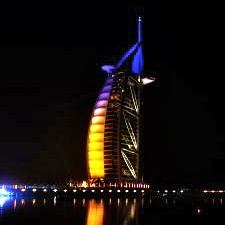 PeterGreenberg.com’s Karen Elowitt recently flew to Dubai for a more in-depth look at the city she once covered in a day. Elowitt will report daily on her discoveries, and figure out whether the glitz and glamour is just a façade, or whether there is a real city with a real soul residing within the myth.
PeterGreenberg.com’s Karen Elowitt recently flew to Dubai for a more in-depth look at the city she once covered in a day. Elowitt will report daily on her discoveries, and figure out whether the glitz and glamour is just a façade, or whether there is a real city with a real soul residing within the myth.
What many people don’t realize about Dubai is that the massive development that has defined this small piece of global real estate for the last 30 years is almost entirely driven by the ruler of the Emirate, Sheik Mohammed bin Rashid al Maktoum.
All the famous projects that garner international attention—the palm tree island development, the Burj al Arab hotel, the Burj Dubai (the world’s tallest building), The World archipelago—are part of Sheikh Mohammed’s “vision” to turn Dubai into a world-class business, tourism and cultural center.
Through government-backed development companies and public-private partnerships, he (and his father before him) has rapidly transformed the landscape of Dubai from that of a dusty Arab fishing village into a booming multinational metropolis.
It’s difficult to recall any other cities that have grown so quickly and so successfully through the determination of one leader. It is also an example of the transformative power that travel and tourism can have on an economy, a subject Dubai wrote the book on. 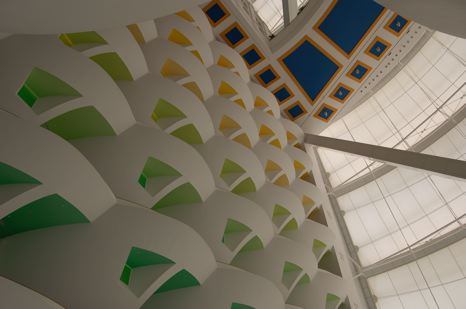 If your oil reserves are scant (neighboring Abu Dhabi has most of it) and you have few other options, why not reinvent yourself as a travel destination and financial metropolis?
If your oil reserves are scant (neighboring Abu Dhabi has most of it) and you have few other options, why not reinvent yourself as a travel destination and financial metropolis?
The most interesting part is that Sheikh Mohammed is apparently just getting started; his vision is only 10 percent complete. Over the next few decades—and despite the current global economic malaise—he still plans to expand exponentially. At least 50 hotels are on the drawing board to be added to the existing palm island development, and two even bigger palm islands are in the works which will add about 40 miles of coastline to Dubai. A massive theme park will be built in Dubailand, and the metro rail will eventually be extended all the way to Abu Dhabi, 60 miles away. The list goes on and on.
Don’t miss Karen’s Dispatch from Dubai, Part One: Getting There.
But how does his vision square with the current economic situation? And how does it hold up in purely practical terms? Is it really feasible to continue to believe that “if he builds it, they will come”—forever?
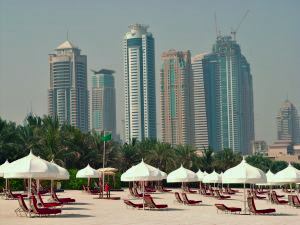 Right now Dubai is in a slump. The skyline at night reveals tell-tale signs of the downturn, as half-finished skyscrapers lurk darkly alongside their completed, brightly-lit brethren. Property prices have plummeted, expats are allegedly abandoning cars at the airport in their haste to get home, and those who remain are buying fewer goods in the numerous glittery malls.
Right now Dubai is in a slump. The skyline at night reveals tell-tale signs of the downturn, as half-finished skyscrapers lurk darkly alongside their completed, brightly-lit brethren. Property prices have plummeted, expats are allegedly abandoning cars at the airport in their haste to get home, and those who remain are buying fewer goods in the numerous glittery malls.
Some media observers have written almost gleefully about “the fall” of Dubai, as if it deserves to be knocked down a notch after what they claim was foolishly, almost greedily, overreaching itself. But to others, the hype surrounding Dubai’s fall may be just as meaningless as the hype that surrounded its buildup. Some of Dubai’s more outlandish projects seem to make it a magnet for hype, but to really evaluate the decline you have to look at the facts, not the façade.
Dubai doesn’t seem to be better or worse off than any other major city in the world that is similarly affected by the recession. Dubai tourism officials claim that development projects that are already announced or in process will be finished, while most of the rest will be placed on hold until things look up again. Only 2 percent of projects have been outright canceled.
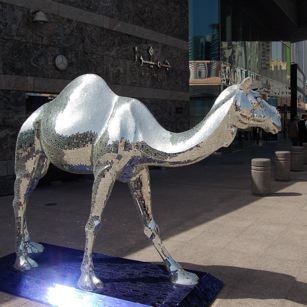 This means that the new airport, the Dubailand theme park, and the nearly complete first phase of the metro rail will go ahead as planned, while untold hundreds of other projects will stay visions in Sheikh Mohammed’s mind for the time being.
This means that the new airport, the Dubailand theme park, and the nearly complete first phase of the metro rail will go ahead as planned, while untold hundreds of other projects will stay visions in Sheikh Mohammed’s mind for the time being.
Curiously, the recession isn’t hitting the tourism sector as hard as you’d think. The business hotels are suffering the most, as the financial services industry’s struggles have led to a drop in corporate travel. The hotel I’m staying in now, the Jumeirah Emirates Towers, is right in the heart of Dubai’s financial district and currently has only 48 percent occupancy.
But hotels that cater to leisure tourists seem to be doing better. The swank new Address hotel claims to have 80 percent occupancy, and the larger-than-life Atlantis Palm boasts around 75 percent. This is not as good as the 90 percent occupancy rates that were common last year, but it’s better than nothing.
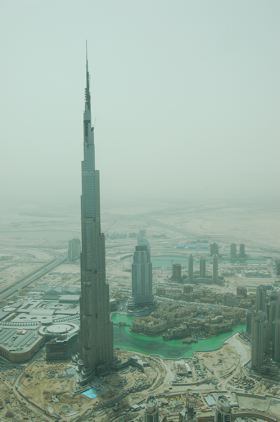 The relatively good performance is most likely due to the fact that room rates have come down by an average of 25 percent from 12 months ago, making Dubai more competitive and affordable than it has ever been. One unintended side effect of the recession has been to make Dubai accessible to more than just rich jet-setters.
The relatively good performance is most likely due to the fact that room rates have come down by an average of 25 percent from 12 months ago, making Dubai more competitive and affordable than it has ever been. One unintended side effect of the recession has been to make Dubai accessible to more than just rich jet-setters.
Interestingly, official data shows that the number of hotel guest nights fell 16 percent in the first quarter of 2009, but the total number of guests was up 3.7 percent. This means that actually more people are visiting Dubai, but they are just not staying as many days.
These statistics seem to bode well for the future, and point to a strong comeback for tourism when the recession ends. However, whether or not the Sheik’s vision to turn Dubai into a town 10 times its current size is realistic is another matter entirely.
That will be determined not only by how well and how fast Dubai recovers, but also by whether or not people will continue to find it a hospitable environment to work, live and visit.
As of 2008 1.7 million people chose to live there, and another 7.5 million visited, so the argument can be made that Dubai must be doing something right. But what makes it so attractive to so many, and what are the downsides? You’ll have to read the next dispatch to find out.
By Karen Elowitt for PeterGreenberg.com.
Read the next entry in the series: Dispatch from Dubai, Part 3: Dispelling Middle Eastern Myths.
For more information, check out:












